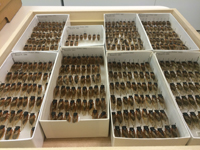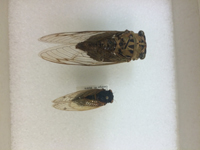KU events will celebrate cicada emergence
 LAWRENCE — Annual cicadas are as much a part of summer in Kansas as the unrelenting heat of August, but this month – and once every 17 years – a different cicada song pulses across eastern Kansas.
LAWRENCE — Annual cicadas are as much a part of summer in Kansas as the unrelenting heat of August, but this month – and once every 17 years – a different cicada song pulses across eastern Kansas.
To celebrate the appearance of the cicada M. cassini, which has not been seen since 1998, the KU Natural History Museum and the Kansas Biological Survey will offer several opportunities to learn more about these insects:
Summer Sirens, an adventurous dining event, will take place under the trees of South Park at 7 p.m. June 4. Participants can enjoy beer and wine as well as meats prepared by Hank Charcuterie. The event also features information about the ecology of these insects and the implications of turning to arthropods for protein as people have been doing for centuries. Tickets are $30 and available at the KU Natural History Museum and online through Free State Brewing Co., shop.freestatebrewing.com.
 Pop-Up Science: Cicadas, will be held at the KU Field Station north of Lawrence when the cicadas begin to emerge. The time and date for this free drop-in education event will be announced online and is likely in the first week of June.
Pop-Up Science: Cicadas, will be held at the KU Field Station north of Lawrence when the cicadas begin to emerge. The time and date for this free drop-in education event will be announced online and is likely in the first week of June.
Cicadas will also be the topic of discussion at the next Science on Tap at 7:30 p.m. June 9 at Free State Brewing Co. Robert Hagen, field education coordinator of the KU Environmental Studies Program, will lead this discussion-and-answer questions about cicadas and their life cycle.
When ground conditions are just right – about 18 degrees Celsius (or about 64 degrees Fahrenheit), tens of millions of adult M. cassini will emerge in the last part of May and early June to mate, lay eggs and die.
Their lifespan above ground is short, usually not longer than two weeks. The insects make a rapid pulsing sound in an effort to find mates. They leave their exoskeletons attached to tree bark and other rough surfaces. Animals such as birds looking for easy, dense protein sources feast upon the insects for several days.
 “Since 1998, nymphs of these 17-year periodical cicadas have been feeding on tree roots underground, unseen,” Hagen said. “Now they are mature and ready to make their noisy appearance above ground. We’re excited to experience this and share it with the public as well as conduct research to answer the many questions that remain about these insects’ ecology and role in forest communities.”
“Since 1998, nymphs of these 17-year periodical cicadas have been feeding on tree roots underground, unseen,” Hagen said. “Now they are mature and ready to make their noisy appearance above ground. We’re excited to experience this and share it with the public as well as conduct research to answer the many questions that remain about these insects’ ecology and role in forest communities.”
Photos, from top: Single specimen of Magicicada cassinii collected May 16 north of Lawrence; the KU Biodiversity Institute's collections of M. cassini are representative of the broods that emerged from the late 1800s to the present; the cicada Tibicen pruinosus is most commonly seen in Kansas annually in late summer and is much larger than the 17-year cicada M. cassini that is emerging now.